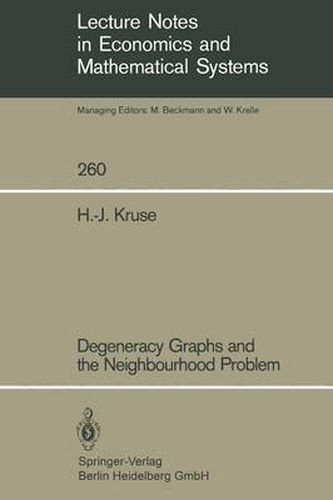Readings Newsletter
Become a Readings Member to make your shopping experience even easier.
Sign in or sign up for free!
You’re not far away from qualifying for FREE standard shipping within Australia
You’ve qualified for FREE standard shipping within Australia
The cart is loading…






This title is printed to order. This book may have been self-published. If so, we cannot guarantee the quality of the content. In the main most books will have gone through the editing process however some may not. We therefore suggest that you be aware of this before ordering this book. If in doubt check either the author or publisher’s details as we are unable to accept any returns unless they are faulty. Please contact us if you have any questions.
A few years ago nobody would have anticipated that in connection with degeneracy in Linear Programming quite a new field. could originate. In 1976 a very simple question has been posed: in the case an extreme pOint (EP) of a polytope is degenerate and the task is to find all neighbouring EP’s of the degenerate EP, is it necessary to determine all basic solutions of the corresponding equalities system associated with the degenerate EP -in order to be certain to determine all neighbours of this EP? This question implied another one: Does there exists a subset of the mentioned set of basic solutions such that it suffices to find such a subset in order to determine all neighbours? The first step to solve these questions (which are motivated in the first Chapter of this book) was to define a graph (called degeneracy graph) the nodes of which correspond to the basic solutions. It turned out that such a graph has some special properties and in order to solve the above questions firstly these properties had to be investigated. Also the structure of degeneracy graphs playes hereby an important role. Because the theory of degeneracy graphs was quite new, it was necessary to elaborate first a completely new terminology and to define new notions. Dr.
$9.00 standard shipping within Australia
FREE standard shipping within Australia for orders over $100.00
Express & International shipping calculated at checkout
This title is printed to order. This book may have been self-published. If so, we cannot guarantee the quality of the content. In the main most books will have gone through the editing process however some may not. We therefore suggest that you be aware of this before ordering this book. If in doubt check either the author or publisher’s details as we are unable to accept any returns unless they are faulty. Please contact us if you have any questions.
A few years ago nobody would have anticipated that in connection with degeneracy in Linear Programming quite a new field. could originate. In 1976 a very simple question has been posed: in the case an extreme pOint (EP) of a polytope is degenerate and the task is to find all neighbouring EP’s of the degenerate EP, is it necessary to determine all basic solutions of the corresponding equalities system associated with the degenerate EP -in order to be certain to determine all neighbours of this EP? This question implied another one: Does there exists a subset of the mentioned set of basic solutions such that it suffices to find such a subset in order to determine all neighbours? The first step to solve these questions (which are motivated in the first Chapter of this book) was to define a graph (called degeneracy graph) the nodes of which correspond to the basic solutions. It turned out that such a graph has some special properties and in order to solve the above questions firstly these properties had to be investigated. Also the structure of degeneracy graphs playes hereby an important role. Because the theory of degeneracy graphs was quite new, it was necessary to elaborate first a completely new terminology and to define new notions. Dr.